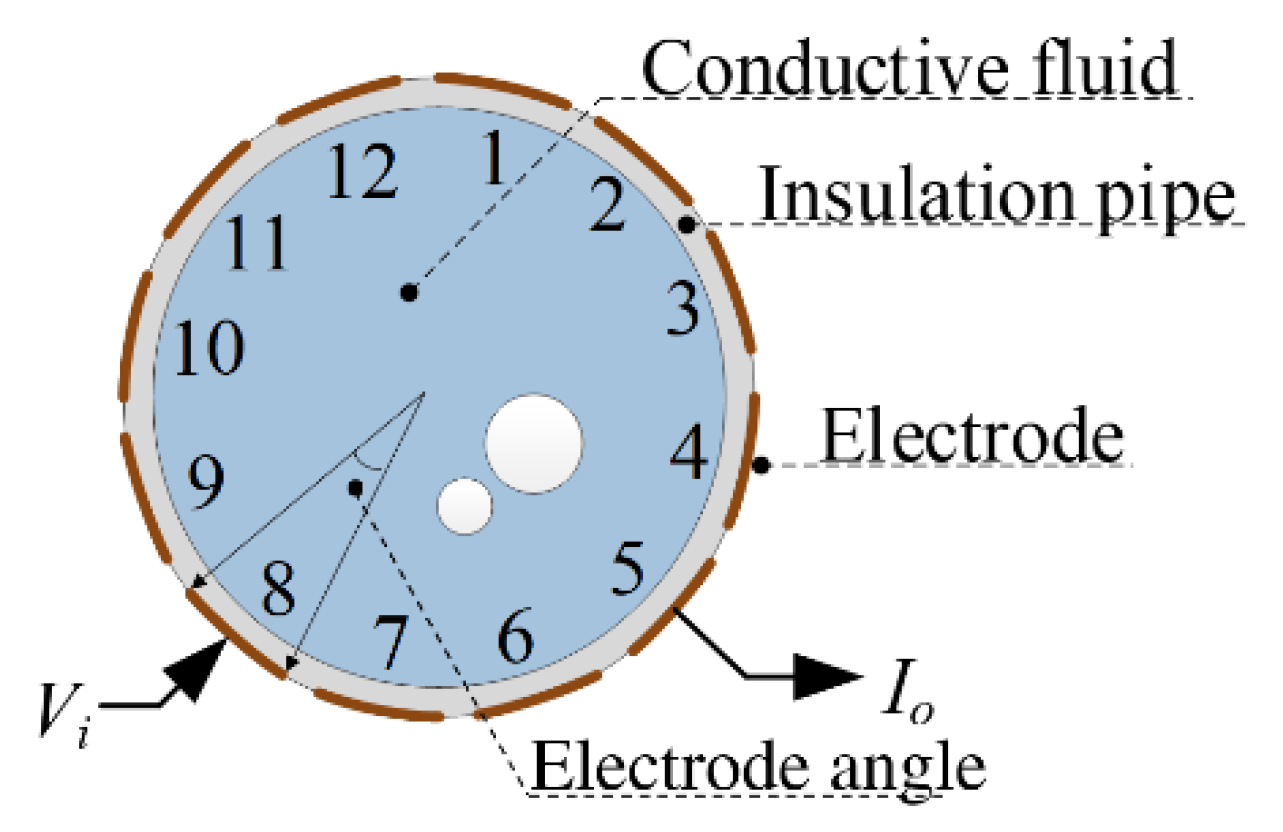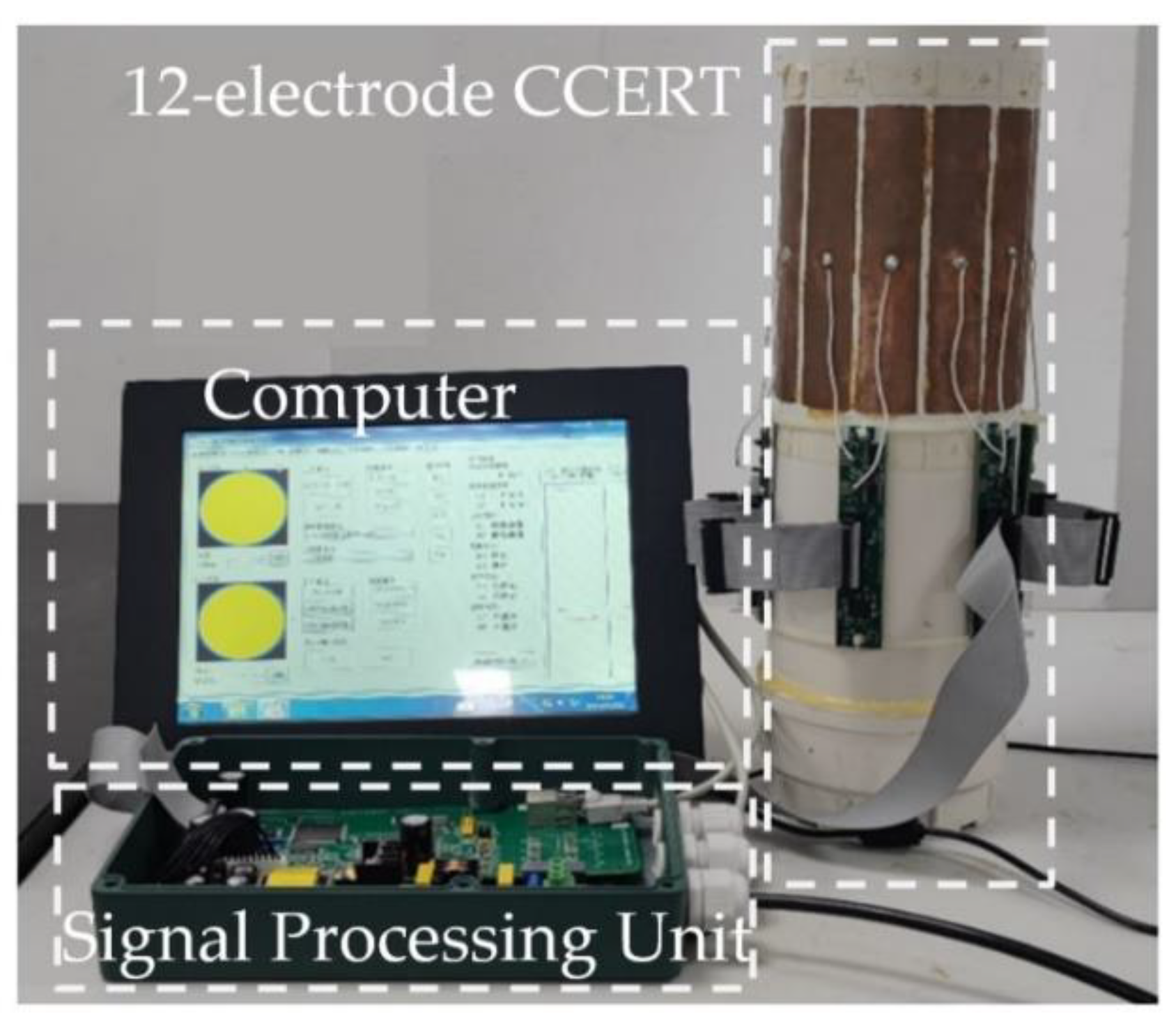On the Image Reconstruction of Capacitively Coupled Electrical Resistance Tomography (CCERT) with Entropy Priors
Abstract
1. Introduction
2. Methods
2.1. Measurement Principle of CCERT
2.2. Image Reconstruction with Regularization
2.3. Image Reconstruction with Entropy Priors
2.3.1. Regularization with Maximum Entropy (ME) Strategy
- (1)
- Maximum Image Entropy (MIE)
- (2)
- Maximum Projection Entropy (MPE)
- (3)
- Maximum Joint Entropy (MJE)
2.3.2. Regularization with Minimum Cross-Entropy (MCE) Strategy
2.3.3. Image Reconstruction Process
- Let the number of iterations and initialize the image vector .
- Calculate the gradient and set the initial iteration direction .
- Determine the step length by linear searching as .
- Calculate the new image vector .
- Calculate the new gradient .
- Update the iteration direction as .
- Set , if either of the termination conditions is satisfied, stop the iteration and let the final image vector to be . Otherwise, return to step 3.
- (1)
- (2)
- (3)
3. Results and Discussion
3.1. Experimental Setup
3.2. Experimental Results and Discussion
4. Conclusions
Author Contributions
Funding
Institutional Review Board Statement
Data Availability Statement
Conflicts of Interest
References
- Crowe, C.T. Multiphase Flow Handbook; CRC Press: Boca Raton, FL, USA, 2006. [Google Scholar]
- Falcone, G.; Hewitt, G.F.; Alimonti, G.F. Multiphase Flow Metering; Elsevier: Oxford, UK, 2010. [Google Scholar]
- Tan, C.; Jia Zhao, J.; Dong, F. Gas–water two-phase flow characterization with electrical resistance tomography and multivariate multiscale entropy analysis. ISA Trans. 2015, 55, 241–249. [Google Scholar] [CrossRef] [PubMed]
- Aw, S.R.; Rahim, R.A.; Rahiman, M.H.F.; Yunus, F.R.M.; Goh, C.L. Electrical resistance tomography: A review of the application of conducting vessel walls. Powder Technol. 2014, 254, 256–264. [Google Scholar] [CrossRef]
- Wang, M. Industrial Tomography: Systems and Applications; Woodhead Publishing: Sawston, UK, 2015. [Google Scholar]
- Wahab, Y.A.; Rahim, R.A.; Rahiman, M.H.F.; Aw, S.R.; Yunus, F.R.M.; Goh, C.L.; Rahim, H.A.; Ling, L.P. Non-invasive process tomography in chemical mixtures—A review. Sens. Actuators B Chem. 2015, 210, 602–617. [Google Scholar] [CrossRef]
- Wang, B.; Hu, Y.; Ji, H.; Huang, Z.; Li, H. A novel electrical resistance tomography system based on C4D technique. IEEE Trans. Instrum. Meas. 2013, 62, 1017–1024. [Google Scholar] [CrossRef]
- Wang, Y.; Wang, B.; Huang, Z.; Ji, H.; Li, H. New capacitively coupled electrical resistance tomography (CCERT) system. Meas. Sci. Technol. 2018, 29, 104007. [Google Scholar] [CrossRef]
- Wahab, Y.A.; Rahim, R.A.; Ling, L.P.; Rahiman, M.H.F.; Aw, S.R.; Yunus, F.R.M.; Rahim, H.A. Optimisation of electrode dimensions of ERT for non-invasive measurement applied for static liquid-gas regime identification. Sens. Actuators A Phys. 2018, 270, 50–64. [Google Scholar] [CrossRef]
- Yang, W.Q.; Peng, L. Image reconstruction algorithms for electrical capacitance tomography. Meas. Sci. Technol. 2002, 14, R1–R13. [Google Scholar] [CrossRef]
- Cui, Z. A review on image reconstruction algorithms for electrical capacitance/resistance tomography. Sens. Rev. 2016, 36, 429–445. [Google Scholar] [CrossRef]
- Jiang, Y.; Huang, J.; Ji, H.; Wang, B.; Huang, Z.; Soleimani, M. Study on dual-frequency imaging of capacitively coupled electrical impedance tomography: Frequency optimization. IEEE Trans. Instrum. Meas. 2022, 71, 1–18. [Google Scholar] [CrossRef]
- Chambolle, A.; Lions, P.L. Image recovery via total variation minimization and related problems. Numer. Math. 1997, 76, 167–188. [Google Scholar] [CrossRef]
- Johnston, P.R.; Gulrajani, R.M. Selecting the corner in the L-curve approach to Tikhonov regularization. IEEE Trans. Biomed. Eng. 2000, 47, 1293–1296. [Google Scholar] [CrossRef]
- Zhou, Z.; dos Santos, G.S.; Dowrick, T.; Avery, J.; Sun, Z.; Xu, H.; Holder, D.S. Comparison of total variation algorithms for electrical impedance tomography. Physiol. Meas. 2015, 36, 1193–1209. [Google Scholar] [CrossRef] [PubMed]
- Yan, H.; Wang, Y.; Wang, Y.; Zhou, Y. An ECT image reconstruction algorithm based on object-and-background adaptive regularization. Meas. Sci. Technol. 2020, 32, 015402. [Google Scholar] [CrossRef]
- Li, S.; Wang, H.; Liu, T.; Cui, Z.; Chen, J.N.; Xia, Z.; Guo, Q. A fast Tikhonov regularization method based on homotopic mapping for electrical resistance tomography. Rev. Sci. Instrum. 2022, 93, 043709. [Google Scholar] [CrossRef] [PubMed]
- Vauhkonen, M.; Vadasz, D.; Karjalainen, P.A.; Somersalo, E.; Kaipio, J.P. Tikhonov regularization and prior information in electrical impedance tomography. IEEE Trans. Med. Imaging 1998, 17, 285–293. [Google Scholar] [CrossRef] [PubMed]
- Watzenig, D.; Fox, C. A review of statistical modelling and inference for electrical capacitance tomography. Meas. Sci. Technol. 2009, 20, 052002. [Google Scholar] [CrossRef]
- Gull, S.F.; Newton, T.J. Maximum entropy tomography. Appl. Opt. 1986, 25, 156–160. [Google Scholar] [CrossRef]
- Denisova, N.V. Maximum-entropy-based tomography for gas and plasma diagnostics. J. Phys. D Appl. Phys. 1998, 31, 1888. [Google Scholar] [CrossRef]
- Wan, X.; Wang, P.; Zhang, Z.; Zhang, H. Fused entropy algorithm in optical computed tomography. Entropy 2014, 16, 943–952. [Google Scholar] [CrossRef]
- Prakash, J.; Mandal, S.; Razansky, D.; Ntziachristos, V. Maximum entropy based non-negative optoacoustic tomographic image reconstruction. IEEE Trans. Biomed. Eng. 2019, 66, 2604–2616. [Google Scholar] [CrossRef]
- Thomas, M.C.; Joy, A.T. Elements of Information Theory, 2nd ed.; Wiley: Hoboken, NJ, USA, 2006. [Google Scholar]
- Som, S.; Hutton, B.F.; Braun, M. Properties of minimum cross-entropy reconstruction of emission tomography with anatomically based prior. IEEE Trans. Nucl. Sci. 1998, 45, 3014–3021. [Google Scholar] [CrossRef]
- Skoglund, U.; Öfverstedt, L.; Burnett, R.M.; Bricogne, G. Maximum-Entropy three-dimensional reconstruction with deconvolution of the contrast transfer function: A test application with adenovirus. J. Struct. Biol. 1996, 117, 173–188. [Google Scholar] [CrossRef] [PubMed]
- Wan, X.; Yi, J. Emission spectral tomography reconstruction based on maximum entropy interpolation. J. Light. Technol. 2009, 27, 780–785. [Google Scholar] [CrossRef]
- Wang, Q.; Wang, H.; Hao, K.; Dai, P. Two-Phase Flow regime identification based on cross-entropy and information extension methods for computerized tomography. IEEE Trans. Instrum. Meas. 2011, 60, 488–495. [Google Scholar] [CrossRef]
- Barbuzza, R.; Clausse, A. Tomography reconstruction by entropy maximization with smoothing filtering. Inverse Probl. Sci. Eng. 2010, 18, 711–722. [Google Scholar] [CrossRef]
- Ardekani, B.A.; Braun, M.; Hutton, B.F.; Kanno, I.; Iida, H. Minimum cross-entropy reconstruction of PET images using prior anatomical information. Phys. Med. Biol. 1996, 41, 2497. [Google Scholar] [CrossRef]
- Mejia, J.; Ochoa, A.; Mederos, B. Reconstruction of PET images using cross-entropy and field of experts. Entropy 2019, 21, 83. [Google Scholar] [CrossRef]
- Mohammad-Djafari, A.; Demoment, G. Maximum entropy image reconstruction in X-ray and diffraction tomography. IEEE Trans. Med. Imaging 1988, 7, 345–354. [Google Scholar] [CrossRef]
- Mwambela, A.; Isaksen, Ø.; Johansen, G. The use of entropic thresholding methods in reconstruction of capacitance tomography data. Chem. Eng. Sci. 1997, 52, 2149–2159. [Google Scholar] [CrossRef]
- Fan, W.; Wang, H. Maximum entropy regularization method for electrical impedance tomography combined with a normalized sensitivity map. Flow Meas. Instrum. 2010, 21, 277–283. [Google Scholar] [CrossRef]
- Wang, M.; Liu, S.; Liang, Y. Bayesian maximum entropy applied to fluid measurement. J. Phys. Conf. Ser. 2018, 1064, 012070. [Google Scholar] [CrossRef]
- Arora, R.K. Optimization: Algorithms and Applications; Chapman and Hall: Boca Raton, FL, USA; CRC: Boca Raton, FL, USA, 2015. [Google Scholar]
- Simon, D. Evolutionary Optimization Algorithms: Biologically-Inspired and Population-Based Approaches to Computer Intelligence; Wiley: Hoboken, NJ, USA, 2014. [Google Scholar]
- Wang, Z.; Bovik, A.C.; Sheikh, H.R.; Simoncelli, E.P. Image quality assessment: From error visibility to structural similarity. IEEE Trans. Image Process. 2004, 13, 600–612. [Google Scholar] [CrossRef] [PubMed]
- Ye, J.; Wang, H.; Yang, W. Characterization of a multi-plane electrical capacitance tomography sensor with different numbers of electrodes. Meas. Sci. Technol. 2016, 27, 035103. [Google Scholar] [CrossRef]
- Shen, J.; Meng, S.; Wang, J.; Yang, W.; Ye, M. Study on the shape of staggered electrodes for 3-D electrical capacitance tomography sensors. IEEE Trans. Instrum. Meas. 2020, 70, 1–10. [Google Scholar] [CrossRef]








Disclaimer/Publisher’s Note: The statements, opinions and data contained in all publications are solely those of the individual author(s) and contributor(s) and not of MDPI and/or the editor(s). MDPI and/or the editor(s) disclaim responsibility for any injury to people or property resulting from any ideas, methods, instructions or products referred to in the content. |
© 2023 by the authors. Licensee MDPI, Basel, Switzerland. This article is an open access article distributed under the terms and conditions of the Creative Commons Attribution (CC BY) license (https://creativecommons.org/licenses/by/4.0/).
Share and Cite
Su, Z.; Soleimani, M.; Jiang, Y.; Ji, H.; Wang, B. On the Image Reconstruction of Capacitively Coupled Electrical Resistance Tomography (CCERT) with Entropy Priors. Entropy 2023, 25, 148. https://doi.org/10.3390/e25010148
Su Z, Soleimani M, Jiang Y, Ji H, Wang B. On the Image Reconstruction of Capacitively Coupled Electrical Resistance Tomography (CCERT) with Entropy Priors. Entropy. 2023; 25(1):148. https://doi.org/10.3390/e25010148
Chicago/Turabian StyleSu, Zenglan, Manuchehr Soleimani, Yandan Jiang, Haifeng Ji, and Baoliang Wang. 2023. "On the Image Reconstruction of Capacitively Coupled Electrical Resistance Tomography (CCERT) with Entropy Priors" Entropy 25, no. 1: 148. https://doi.org/10.3390/e25010148
APA StyleSu, Z., Soleimani, M., Jiang, Y., Ji, H., & Wang, B. (2023). On the Image Reconstruction of Capacitively Coupled Electrical Resistance Tomography (CCERT) with Entropy Priors. Entropy, 25(1), 148. https://doi.org/10.3390/e25010148





